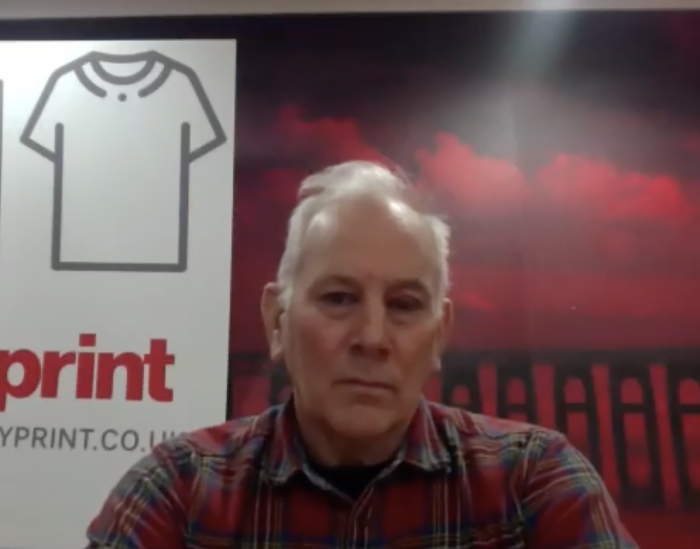As online product ordering continues apace, should the large-format print sector be doing more to embrace W2P? What are the stumbling blocks to successful implementation and a good ROI? What do suppliers of W2P solutions need to do to help PSPs transition? Here’s what print chiefs have to say in in answer to these big questions.

Richard McCombe, Matic Media Services
Online product sales continue to rise, so should large-format compnies get more involved? Historically we have seen big names in print embrace online trading, using websites to upload artwork, prefight and proof and send into workflow. This has worked successfully for many products because they are fixed size and can be shipped easily around the UK or even Europe. With fixed sized products you can easily standardise your workflow and find software on the marketplace that will ‘plug-in’ to websites, and there has been an uptake in customisation of mugs, T-shirts, pillowcases to reflect the growing personalisation marketplace.
As the big guns with the resource in technology take a growing market share by cross-selling to their existing customers, or cross sell to new customers through mergers and acquisitions, they will be able to invest in the technology required to sell a wider range of products.
Since the start of the global Covid-19 pandemic we have seen an uptake in selling online of commoditised products which have a fixed shape, size and maybe even artwork - I’m talking about floor stickers, clear roller blinds, sneeze guards and even faceshields. These products all can be commoditised and with few variations it is easy to set-up a website, take orders, print, cut, pack and mail out. I believe this is why so many have realised that trading online is important and within the grasp of many.
However, software is a big problem. We have been trading online since 2012 with our own back-end development done in-house. We used the experience of selling 400,000 photo canvas through a daily deal site to develop our own trade print service at www.GraphicWarehouse.co.uk. Developing in-house has allowed us to continually improve and not be dependent on a third party. If your site does go down and you don’t have the ability to receive orders then you may lose a customer.
This is more important than ever as clients become accustomed to trading through your website - with less interaction, you now do not have that account managed relationship you would have had with your best customers. Saying that, we have found the biggest myth in online trading is that customers will trade without speaking to you. This is not true.
We have found that by supporting customers in a traditional way - phone calls, emails and now online chat - we are building confidence through the relationship with our customer service team. This is a whole subject matter in itself.
We do not expect our customers to process their orders without support. Early in the relationship our customer service team will process the order online for the client, this includes quoting, uploading artwork, proofing and editing bleeds all in the exact same way the client could but with our website it is so quick we can do it within 60 seconds!
Another barrier for large-format PSPs is size. Since the demise of Citylink, size has become a real headache. ‘Dirty freight’ - anything over 1.6m (or 1m for DPD) - is the pariah of the couriers. They do not want to handle it. So, 8ft x 4ft sheets, 130cm-wide wallpaper, and 3m PVC banners (no one wants these folded) are all a total pain.
We have had to devise a module in our system that calculates the package size of goods to calculate the correct carrier. Smaller businesses have little bargaining power with the large couriers and they charge additional fees for goods not packaged to their expectations with no warning. We put dirty freight and smaller goods with different carriers, which the system decides. Our system then notifies the carrier, prints out the label and then notifies the client to allow them to track their order themselves. This is done through portals called API’s, which allow computerised systems to talk to each other. We had to build one from scratch for one of our carriers - which is not small but did not have an API to allow it to integrate with us - as we were becoming inundated with ‘Where is my order?” communications from clients.
API’s then - we have toyed with the idea of making our own system available but this leads to the next challenge. Do PSP’s have even the rudimental knowledge of software integration to even start the process of bringing in experts? I’m 48 years old. When I was at school BBC computers were just being integrated. That means that many around my age will have ‘the fear’. You will start to see API’s become available from the larger PSP’s (some are already available) but these are not websites. They are the modules available to integrate into your own website but this takes some skill and not a graphic designer who can build an e-commerce website.
W2P ROI is a long burn. No-one creates a website and their customers simply start to buy online. If you do, you will need very deep pockets to drive traffic to your site through PPC advertising, and organic traffic takes a long time to work your way up the search engines to start driving natural sales. SEO (Search Engine Optimisation) is a cost. If you want to get to the top of the search engines it takes time and small mistakes can be catastrophic.
So, what do W2P developers/suppliers need to do now to help large-format PSPs transition to W2P? Well, W2P is different things to different people. It could be Web-to-print file (PDF), or it could be Web-to-plate (larger commercial printers may use this to gang-up business cards or leaflets), or it might be web-to-press. We can do the latter. Orders from our website are released directly in to hotfolder which are assigned to printers and stocks and can be released automatically to the printer (e.g. posters).
For the customer it is the simplified process of getting a quote and supplying artwork. Our website, GraphicWarehouse.co.uk, allows our customers to get a quote in 20 seconds. They can also upload their artwork, pre-flight, proof and release their artwork directly into our workflow in as little as 60 seconds. The customer can then track their goods directly to the point of delivery. Around 90% of our deliveries are white label direct to our clients’ clients.
For the PSP it is cutting the time it takes to get the order to the press with as little human interaction as possible. If your demographic and offering is a higher value product with few transactions, you don’t need to W2P. If you have many customers with many transactions or many variations, then this will save time. You will not need every piece of artwork checked manually before sending it to the press.
At the end of the day, W2P it is not for everyone and not everyone needs W2P. I firmly believe that where a service is bespoke with few transactios - like a sign maker supplying a house builder - there is little need. However, if you are servicing a range of clients with repeat orders of a similar products it may save you money in the long term.
For the foreseeable future there will still be the need for a hand-held service. I am currently encouraging my clients to get out and sell and use an outsourced model to keep their clients buying a wider range of ‘print’ services and outsource to top performing partners and let us take the burden of technology and Capex.
I think the biggest large-format printer manufacturers are keen to sell the dream of selling online or capitalise on soft furnishings or soft signage, but when it comes down to it they do not have the experience of what is going on at grass-roots level, so be careful of the dream they sell.

Simon Cooper, Solopress
I think providers that already offer W2P will always embrace the latest developments that facilitate online ordering, and a healthy partnership exists between PSPs and suppliers. The question of whether or not a large-format print company should enter the W2P space in the first instance is more complex. Sometimes it’s automatically assumed that W2P is the best route forward, when actually a lot of consideration should go into what’s to be gained, lost or compromised by taking that step.
For one thing, there are a lot of established operators in this space now. With price transparency what it is in our industry, it can be extremely challenging for newcomers to compete. A worst-case scenario for a large-format printer would be to invest a lot of resources in W2P only to find they can’t offer anything better or cheaper than what’s already out there.
Another challenge comes from the compromises providers find themselves forced to make in terms of product options and pricing. As they shift over to engaging with an online audience, the trade-off is often a simplified product offering that can be narrower and less attractive.
So, there’s a danger that small to medium operators can lose something of what made them special in the first place. The popular adage, ‘get big, get niche or get out’ is relevant here. It could be that there are alternative avenues other than W2P that a print provider can take to add value to their offering or serve more specialised markets.
When it comes to the technology side of things, intelligent automation solutions will always be welcome. Developers and suppliers already appreciate how important productivity and efficiency are for print providers. Automation can be a crucial factor in streamlining processes and stripping out waste, be that wasteful processes or physical waste. In a market where efficiency is key, that’s absolutely critical.

James Tay, Tayprint
Should the large-format print sector be doing more to embrace W2P? Yes. But time is the enemy, because it is a big learning curve and it takes months to implement. We have been setting up for nearly four months so far.
As I see it, there needs to be a much slicker approach to the interface between third party software - particularly when it comes to existing accounting packages.
We have struggled a bit to be honest, mainly due to this Covid situation and not having assistance on the ground. Remote set-up really does not work too well. We have had a great deal of additional work to do to implement the whole system

Gary Peeling, Precision Proco Group
Of course the answer to whether the LFP sector be doing more to embrace W2P is ‘yes’.
W2P essentially simplifies the ordering process for factory and customer, that means easier to use which results in more orders that should be easier to manage, with a lower cost of sale. Why would a customer pick up the phone and make an enquiry when other suppliers are providing responses in a few clicks?
In terms of stumbling blocks to successful implementation and ROI, first you have to change your mindset. We are in the main bespoke manufacturers, but in practise we are producing broadly the same products day in and day out with minor changes to attributes, size , material and quantity.
Secondly, you have to step forward boldly, understanding that those that took the path earlier were not really better equipped or prepared than you. Break the project into bite size minimum viable chunks and get something live as soon as you can rather than spending months and years in the planning and preparation of something too ambitious which is difficult to finish and expensive to execute.
Consider the project from back to front - shipping, post press, printing, pre-press and then UX and not the other way round. Make your workflow and factory automated, or at the very least systematic first, then you have the option to connect to other shop fronts and not just your own. In any event, there’s little point in automation for the customer and still being human/job bag led at your end.
Be prepared to fail fast and adjust as you go. Make sure to bring the whole business with you, have answers for questions like ‘Why are we doing these cheap small orders?’, and make sure that the whole business understands why you are going this route.
Don’t be restricted by your own plant and space. Consider sub-contracting to provide more comprehensive services using trade suppliers to make your range more compelling and take a larger share of the wallet spend.
When it comes to what W2P developers/suppliers need to do now to help large-format PSPs transition to W2P, I’d say continue the move to SAAS pay-as-you-go models which reduce risk while getting out of the blocks. Remove the focus from shop-front only and help construct and deliver an end-to-end process which most often will require the collaboration of a number of suppliers and systems.

